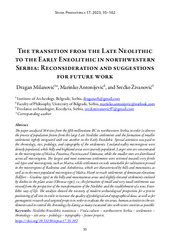Приказ основних података о документу
The transition from the Late Neolithic to the Early Eneolithic in northwestern Serbia: Reconsideration and suggestions for future work
| dc.creator | Milanović, Dragan | |
| dc.creator | Antonijević, Marinko | |
| dc.creator | Živanović, Srećko | |
| dc.date.accessioned | 2023-12-31T18:47:16Z | |
| dc.date.available | 2023-12-31T18:47:16Z | |
| dc.date.issued | 2023 | |
| dc.identifier.uri | http://rai.ai.ac.rs/handle/123456789/1172 | |
| dc.description.abstract | The paper analyzed 364 sites from the fifth millennium BC in northwestern Serbia in order to observe the process of population fission from the large Late Neolithic settlements and the formation of smaller settlements tightly integrated with one another in the Early Eneolithic. Special attention was paid to the chronology, size, pedology, and topography of the settlements. Lowland-valley microregions were densely populated, while hilly and highland areas were sparsely populated. Larger sites are concentrated in the microregions of Mačva, Posavina, Pocerina and Tamnava, while the smaller ones are distributed across all microregions. The largest and most numerous settlements were oriented towards very fertile soil types and microregions, such as Mačva, while settlements on soils unsuitable for cultivation prevail in the microregions of Rađevina and Azbukovica, which are characterized by hills and mountains, as well as in the most populated microregion of Mačva. Hard-to-reach settlements of dominant elevations (hillfort – Gradina type) in the hilly and mountainous areas and slightly elevated settlements enclose by ditches in the plain areas (Obrovac type), i.e., the formation of small and very small settlements was viewed from the perspective of the transformation of the Neolithic and the establishment of a new, Eneolithic way of life. The analysis showed the necessity of modern archaeological prospection for a precise positioning of all sites in order to increase the quality of pedological and topographical data, as well as for geomagnetic research and targeted projects in order to evaluate the site areas, human activities in the settlements and to control the chronology by dating as many excavated sites with secure contexts as possible. | sr |
| dc.language.iso | en | sr |
| dc.publisher | National Archaeological Institute with Museum of the Bulgarian Academy of Sciences (NAIM–BAS) | sr |
| dc.relation | info:eu-repo/grantAgreement/MESTD/Basic Research (BR or ON)/177020/RS// | sr |
| dc.rights | openAccess | sr |
| dc.rights.uri | https://creativecommons.org/licenses/by-nc-nd/4.0/ | |
| dc.source | Studia Praehistorica | sr |
| dc.subject | Neolithic/Eneolithic transition | sr |
| dc.subject | Vinča culture | sr |
| dc.subject | northwestern Serbia | sr |
| dc.subject | settlements | sr |
| dc.subject | chronology | sr |
| dc.subject | site area | sr |
| dc.subject | pedology | sr |
| dc.subject | topography | sr |
| dc.subject | future projects | sr |
| dc.title | The transition from the Late Neolithic to the Early Eneolithic in northwestern Serbia: Reconsideration and suggestions for future work | sr |
| dc.type | article | sr |
| dc.rights.license | BY-NC-ND | sr |
| dc.citation.epage | 102 | |
| dc.citation.issue | 17 | |
| dc.citation.spage | 35 | |
| dc.identifier.doi | https://doi.org/10.53250/stprae17.35-102 | |
| dc.identifier.fulltext | http://rai.ai.ac.rs/bitstream/id/3525/bitstream_3525.pdf | |
| dc.type.version | publishedVersion | sr |


